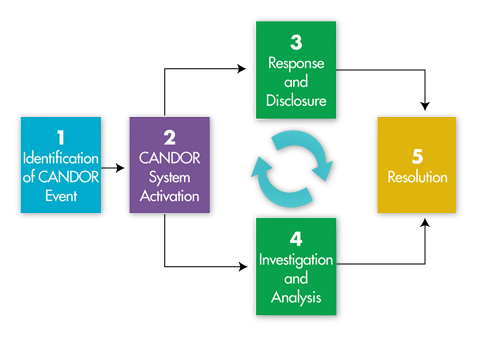Communication and Optimal Resolution (CANDOR) Toolkit

What is the Communication and Optimal Resolution Process?The Communication and Optimal Resolution (CANDOR) process is a process that health care institutions and practitioners can use to respond in a timely, thorough, and just way when unexpected events cause patient harm. Based on expert input and lessons learned from the Agency's $23 million Patient Safety and Medical Liability grant initiative launched in 2009, the CANDOR toolkit was tested and applied in 14 hospitals across three U.S. health systems. |
What Resources Are Included in the CANDOR Toolkit?
The CANDOR toolkit contains eight different modules, each containing PowerPoint slides with facilitator notes. Some modules also contain tools, resources, or videos.
| “We realize mistakes happen, and we can forgive that; but you harm us again by not being honest and transparent with us…we should be healing and learning together how to prevent this from happening to someone else.” Carole Hemmelgarn, Patient Advocate |
How Does the CANDOR Process Work?
Generally, the CANDOR process begins with identification of an event that involves harm. This activates initiation of coordinated post-event processes, as depicted below and described in the CANDOR Toolkit modules.

Why Invest in Implementing the CANDOR Process in My Organization?
Despite the best efforts of hospitals, doctors, nurses and other health care professionals, about 1 in 10 patients is harmed by the care they receive. Harms such as hospital-acquired infections or medication errors can happen during any stage of care.
What Will My Organization Learn?
The key learnings for hospitals implementing the CANDOR process in their institutions include how to:
- Engage patients and families in disclosure communication following adverse events.
- Implement a Care for the Caregiver program for providers involved in adverse events.
- Investigate and analyze an adverse event to learn from it and prevent future adverse events.
- Review and revise the organization’s current processes to align with the CANDOR process.
- Establish a resolution process for the organization.
“At its heart, CANDOR is aimed at stimulating patient safety and optimal patient care…It is only through honesty that we can identify our problems and improve. By focusing on safety improvement, the claims crisis will take care of itself.” Richard C. Boothman, J.D., Chief Risk Officer, University of Michigan Health System |  |
How Can I Learn More About AHRQ's Patient Safety and Medical Liability Reform Initiative?
The goal of this initiative, responding to President Obama's directive, was to improve the overall quality of health care by making patient safety the primary goal. In October 2009, AHRQ announced two funding opportunities that aimed to connect medical liability to patient safety and quality while moving toward a systems-oriented approach to learning and improvement that has been embraced by the patient safety movement. View the Demonstration and Planning Grants Reports here.
Page last reviewed September 2017
Page originally created May 2016
Page originally created May 2016
Internet Citation: Communication and Optimal Resolution (CANDOR) Toolkit. Content last reviewed September 2017. Agency for Healthcare Research and Quality, Rockville, MD. http://www.ahrq.gov/professionals/quality-patient-safety/patient-safety-resources/resources/candor/introduction.html































No hay comentarios:
Publicar un comentario